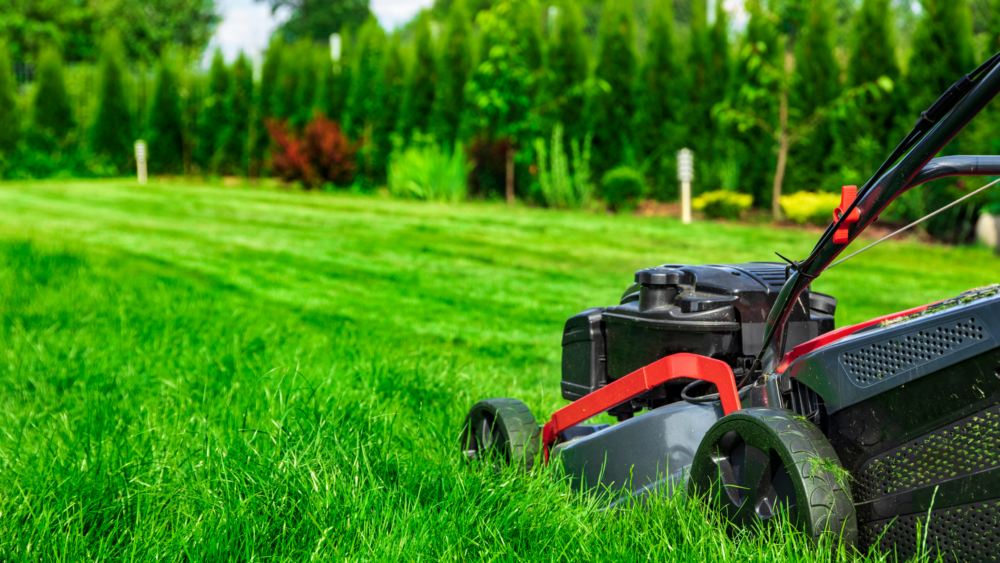Who said having the perfect green lawn has to be hard work? Forget spending every weekend tangled in garden tools. With some savvy lawn care tactics, you can have that vibrant yard without it taking over your life. Whether you’re battling dry patches or just aiming for a more uniform sea of green, there’s no need to call in the pros just yet.
Think about this – with the right approach, even those notorious brown spots can become a thing of the past. It’s not just about watering; it’s knowing when and how much. And let’s not forget mowing – too short is often where things go south! Stick around as we break down these tips into bite-sized chunks anyone can follow.
Common Lawn Care Mistakes to Avoid
Want to keep your turf in tip top shape all season long? Do what I do and read up on what your lawn needs to look its best.
Whether you rely on DIY lawn treatments or hire professionals, your grass must get what it needs during the optimal time frame to thrive. Even something as simple as turning on your sprinklers too late in the day could encourage diseases to crop up (not to mention wasting water).
Treating Broadleaf Weeds When It’s Dry
Treating broadleaf weeds when it’s dry can be ineffective. Weed killers work best when the weeds are actively growing and not under stress.
It’s best to apply weed control after removing weeds and when the lawn is not under any stress.
Applying Weed Preventers Too Late
Applying weed preventers too late can allow weeds to germinate and establish in your lawn. The ideal time to apply pre-emergent herbicides is in early spring before weed seeds start to germinate, typically when soil temperatures reach around 55°F.
Not Fertilizing Your Lawn
Weed Man Lawn Care’s slow-release granular fertilizer is exclusively blended for your turf, offering golf course-quality results. Feeding your lawn regularly with the right nutrients can help it grow lush and thick, which naturally helps in pushing those pesky weeds out of the picture.
Aerating Your Lawn at the Wrong Time
Aerating your lawn at the wrong time of year can stress the grass and make it more susceptible to weeds and disease. The best time to aerate depends on your grass type:
- Cool-season grasses should be aerated in early spring or fall
- Warm-season grasses should be aerated in late spring or early summer
Watering Too Late in the Day
Watering your lawn too late in the day, especially in the evening, can promote fungal growth and disease. Aim to water early in the morning so the grass has time to dry before nightfall.
Not Mowing Frequently Enough
Not mowing frequently enough allows the grass to grow too tall, making it harder to maintain and more prone to pests and disease. Mow regularly, never removing more than one-third of the grass blade height at a time.
Maintaining a Healthy Lawn Throughout the Seasons
Read on for lawn care 101: Here are the most common lawn care mistakes to avoid and how to time all your yard work just right so you end up with the best-looking grass on the block.
Understanding Your Grass Type
The My Lawn app from Scotts generates a personalized lawn care plan based on your specific grass type, location, lawn size, and lawn conditions. Understanding the needs of your particular grass species is key to providing the right care throughout the year.
Proper Watering Techniques
Watering your lawn properly is crucial for its health. Water deeply and infrequently to encourage deep root growth. Avoid watering late in the day, as this can promote fungal growth.
Mowing at the Right Height
Mow your lawn at the proper height for your grass type. Cutting grass too short can stress the lawn and allow weeds to invade. Taller grass helps shade the soil, retaining moisture and preventing weed seeds from germinating.
Fertilizing for Optimal Growth
Your Lawn Doctor technician will come approximately every 6-8 weeks to service your lawn and provide you with a full summary of all lawn services performed, using high-quality materials and equipment. Regular, properly timed fertilization helps your lawn grow thick and lush.
Dethatching and Aerating
Dethatching removes the buildup of dead grass and roots that can prevent water and nutrients from reaching the soil. Aerating relieves soil compaction, allowing air, water, and nutrients to penetrate the grass roots. Both practices promote a healthier lawn.
Overseeding and Filling Bare Spots
Overseeding helps maintain a thick, lush lawn by introducing new grass seed into an existing lawn. It’s super handy when you’re trying to patch up areas that are looking a bit sparse or have thinned out over time. The best time to overseed depends on your grass type.
Dealing with Common Lawn Problems
Identifying and Treating Pest Infestations
Protect your lawn from damaging insects through a properly supervised Weed Man Lawn Care program designed to reduce infestations. Spotting pests early and taking the right steps to deal with them is key if you want to keep your turf from turning into a disaster zone.
Managing Thatch Buildup
Thatch is a layer of dead grass, roots, and stems that accumulates between the soil surface and living grass. While a thin layer of thatch is beneficial, too much can prevent water and nutrients from reaching the soil. Regular dethatching helps manage this buildup.
Addressing Soil Issues
Healthy soil is the foundation of a thriving lawn. Conduct a soil test to determine your soil type, pH level, and nutrient deficiencies. Based on the results, you can amend the soil with the appropriate materials, such as lime for acidic soil or sulfur for alkaline soil.
Reviving Dead or Patchy Grass
Dead or patchy grass can be caused by various factors, including pest damage, disease, or poor maintenance practices. To revive these areas, remove the dead grass, loosen the soil, and reseed with a grass type that matches your lawn. Keep the area moist until the new grass is established.
Eco-Friendly Lawn Care Practices
Using Organic Fertilizers
When you choose organic options for your lawn like compost, bone meal, or blood meal, you’re opting for a natural slow-release nutrient buffet that keeps on giving. These natural alternatives to synthetic fertilizers support healthy soil biology and reduce the risk of nutrient runoff and environmental pollution.
Mulching Grass Clippings
Grass clippings are a valuable source of organic matter and nutrients for your lawn. By mulching your clippings with a mulching mower, you allow them to decompose and return nutrients to the soil, acting as a natural fertilizer. This reduces the need for synthetic fertilizers and helps maintain a healthy, eco-friendly lawn.
Implementing Natural Weed Control Methods
Instead of relying solely on chemical herbicides, consider using natural weed control methods. Hand-pulling, mulching, and maintaining a thick, healthy lawn can help prevent weed growth. You can also tackle those pesky weeds using natural options like vinegar or corn gluten meal, sidestepping the need for harsh chemicals.
Conserving Water
Saving water isn’t just good for the planet; it also keeps your budget happy. Water your lawn deeply and infrequently to encourage deep root growth and drought tolerance. Install a rain sensor or smart irrigation system to avoid overwatering and adjust your watering schedule based on rainfall and weather conditions.
Choosing the Right Grass Seed for Your Lawn
Selecting the right grass seed is crucial for establishing a healthy, resilient lawn that can withstand the challenges of your local climate and soil conditions.
Cool-Season Grasses
Cool-season grasses, such as tall fescue, perennial ryegrass, Kentucky bluegrass, and fine fescues, are best suited for regions with cool summers and cold winters. These grasses thrive in the cooler temperatures of spring and fall and may go dormant during hot, dry summer conditions.
Warm-Season Grasses
Warm-season grasses, including Bermuda grass, Zoysia grass, St. Augustine grass, and Centipede grass, are ideal for regions with hot summers and mild winters. These grasses grow actively during the warm months and turn brown or go dormant when temperatures drop in winter.
Grass Seed Blends
Mixing different types of grass seeds together gives your lawn the superpower to handle just about anything – from a variety of soil conditions and how much sun or shade it gets, to the kind of care you’re able to give it. Blends can also provide better disease resistance and overall lawn health compared to single species lawns.
Factors to Consider When Selecting Grass Seed
When choosing grass seed for your lawn, consider the following factors:
- Climate and temperature range in your region
- Soil type and pH level
- Sun exposure and shade tolerance
- Drought and heat resistance
- Foot traffic and wear tolerance
- Maintenance requirements, such as mowing and fertilizing
By selecting grass seed that is well-suited to your specific growing conditions and maintenance preferences, you can establish a lawn that is both beautiful and resilient.
FAQs in Relation to Lawn Care
What is the best treatment for a lawn?
Aerate, then follow up with overseeding and fertilizing. This combo revives your turf by boosting root growth and density.
How can I make my lawn healthy again?
Water deeply but infrequently to encourage roots to dive deep. Mow higher to protect those roots from scorching sun.
When should I fertilize my lawn?
Fertilize cool-season grasses in early fall and warm-season ones in late spring to fuel their peak growing times.
Should you fertilize or spray for weeds first?
Spray weeds first. Let your yard recover, then feed it. This order helps grass absorb nutrients without competing with weeds.
Conclusion
In our journey through lawn care land, we’ve seen that keeping our grass greener doesn’t require magic—just some know-how and consistency. From understanding when to wield your mower blade at just the right height to mastering the art of timely watering and feeding, these steps are simpler than they seem.
The beauty here is realizing that what seemed like chores are actually small acts of caring for nature—and hey, they reward us with a stunning outdoor space!
So remember, whether you’re looking out at acres or just a modest patch behind your house—every bit counts towards creating something beautiful. So, here’s to basking in the sunshine on your lush green lawn for many days to come!




